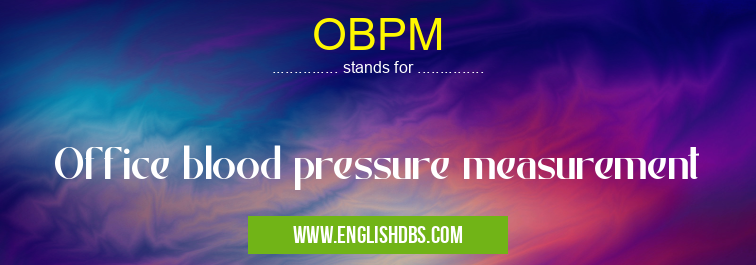What does OBPM mean in HOSPITALS
Office blood pressure measurement (OBPM) is a standard method for assessing an individual's blood pressure in a clinical setting. It involves measuring the pressure exerted by the blood against the walls of the arteries during a routine medical examination.

OBPM meaning in Hospitals in Medical
OBPM mostly used in an acronym Hospitals in Category Medical that means Office blood pressure measurement
Shorthand: OBPM,
Full Form: Office blood pressure measurement
For more information of "Office blood pressure measurement", see the section below.
What is OBPM?
OBPM is a non-invasive procedure that is commonly performed using an inflatable cuff (sphygmomanometer) wrapped around the upper arm. The cuff is inflated to a certain pressure, and then gradually released while listening for Korotkoff sounds, which are audible sounds that indicate the blood flow through the brachial artery. The pressure at which these sounds are first heard represents the systolic blood pressure, while the pressure at which they disappear marks the diastolic blood pressure.
Importance of OBPM
OBPM is crucial for early detection, diagnosis, and management of hypertension, a major risk factor for cardiovascular diseases such as heart attacks and strokes. Regular OBPM allows healthcare providers to monitor blood pressure levels over time and make necessary adjustments to treatment plans.
Advantages of OBPM
- Widely accessible in clinical settings
- Non-invasive and relatively inexpensive
- Provides immediate results
- Can be used to screen for hypertension and other cardiovascular conditions
Limitations of OBPM
- May not reflect true blood pressure measurements due to factors such as anxiety or "white coat hypertension"
- Requires skilled healthcare professionals to perform accurately
- May not be suitable for all individuals, such as those with certain medical conditions
Essential Questions and Answers on Office blood pressure measurement in "MEDICAL»HOSP"
What is office blood pressure measurement (OBPM)?
Office blood pressure measurement (OBPM) is a standard method of measuring blood pressure in a clinical setting. It involves using a sphygmomanometer, an inflatable cuff placed around the upper arm, to determine the pressure exerted by the blood against the artery walls.
Why is OBPM important?
OBPM is important because it provides an indication of a person's overall cardiovascular health. High blood pressure, also known as hypertension, is a major risk factor for heart disease, stroke, kidney disease, and other health problems. OBPM helps healthcare professionals assess a patient's blood pressure and determine if they are at risk for these conditions.
How is OBPM performed?
OBPM is typically performed by a healthcare professional, such as a doctor or nurse. The patient sits with their feet flat on the floor and their arm supported at heart level. The sphygmomanometer cuff is placed snugly around the upper arm, and the healthcare professional inflates the cuff until the brachial artery is occluded. The cuff is then slowly deflated while the healthcare professional listens for the Korotkoff sounds, which are sounds produced by the blood flowing through the artery. The systolic blood pressure is recorded when the first Korotkoff sound is heard, and the diastolic blood pressure is recorded when the last Korotkoff sound disappears.
What are the limitations of OBPM?
OBPM has some limitations, including:
- White-coat hypertension: Some people experience elevated blood pressure readings in a clinical setting due to anxiety or stress. This is known as white-coat hypertension.
- Masked hypertension: Some people have normal blood pressure readings in a clinical setting but elevated blood pressure readings outside of the clinical setting. This is known as masked hypertension.
- Observer variability: Blood pressure readings can vary depending on the healthcare professional performing the measurement.
Final Words: OBPM is a valuable tool for assessing blood pressure and identifying individuals at risk for cardiovascular disease. While it has certain limitations, OBPM remains a widely used and effective method for screening, diagnosis, and monitoring of hypertension. By providing healthcare providers with accurate and timely blood pressure measurements, OBPM helps promote early intervention and preventive measures for improved cardiovascular health.
